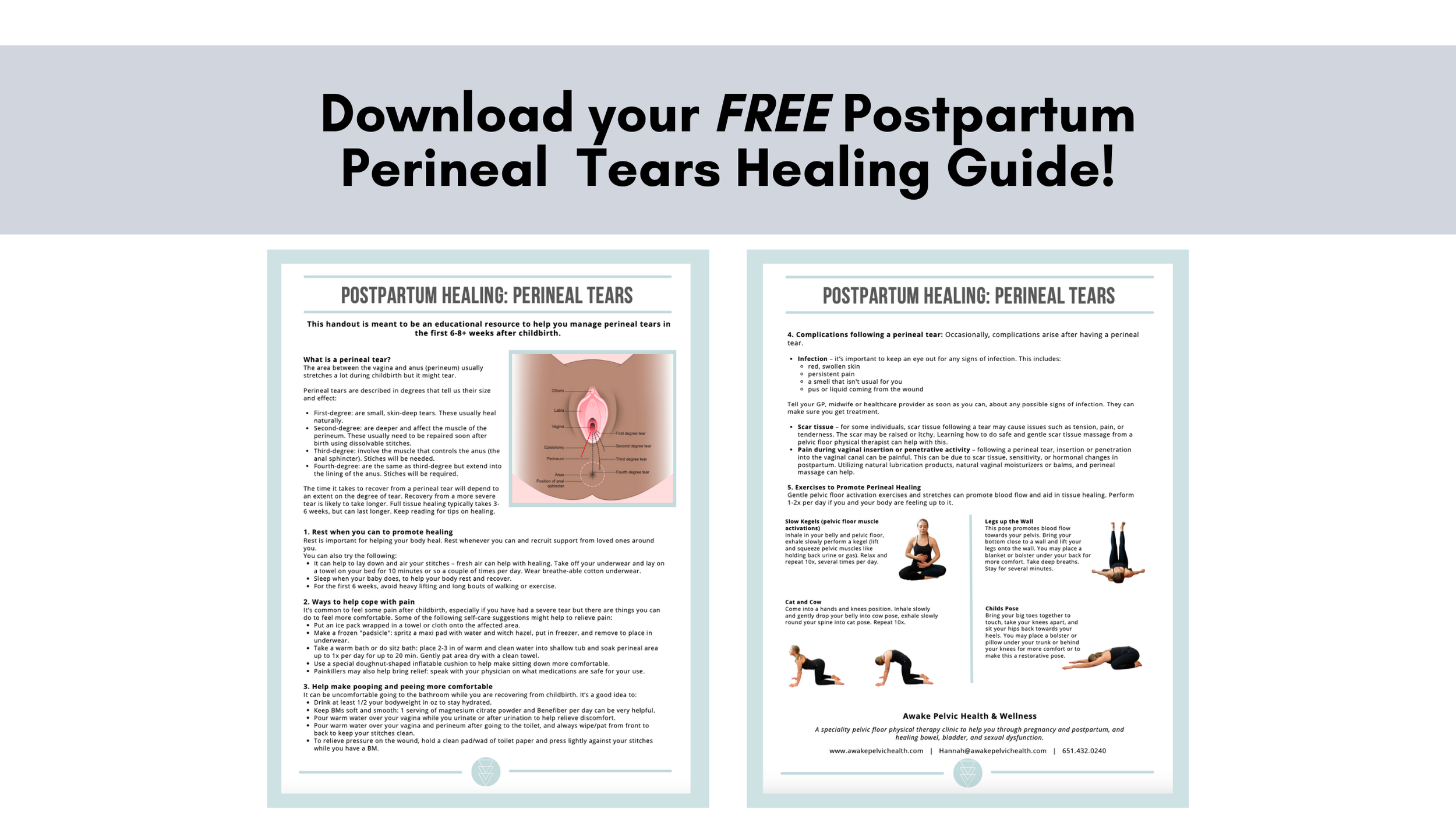Perineal Tears & Episiotomy: How Pelvic PT can Help!
During a vaginal birth it is possible to experience tears in the perineum as your body is born. Some women may experience an episiotomy (a type of perineal tear and specific cut to the perineal tissues to give space to birth baby). There is SO much that you can do to help facilitate healing of perineal tears after your birth, even if you gave birth several years ago (most women are never taught any of this when they leave the hospital or birth center!). In this blog post we will discuss what perineal tears are, tear prevention strategies, simple postpartum healing tips, and how a Pelvic Floor Physical Therapist can be a vital part of your postpartum journey.
What is a Perineal Tear?
There are different grades of tears and directions that a tear can go:
Grade 1: Superficial Perineal Tissues (usually only just a few stitches, if any)
Grade 2: Perineal Muscle has torn (most common)
Grade 3: Less than 50% of the anal sphincter has torn
Grade 4: Over 50% of the anal sphincter has torn
Depending on the grade of tear, healing can be relatively simple to quite painful. At Awake Pelvic Health, we educate our patients on the tools to prepare for your birth bag and for home prior to giving birth (such as a peri bottle, perineal ice packs, sitz bath, etc) to help with healing and pain management. Additionally, we recommend our patients start taking stool softeners several days before giving birth to reduce pain with bowel movements (since that first postpartum poop can be tough!)
Scar Tissue After Tearing
The body’s natural response is to form a scar at and around torn tissues or muscles. While scar tissue formation is a natural response, it can cause “stickiness” or adhesions in the perineum, leading to common issues such as:
Painful or urgency bowel movements
Painful sex and penetration
Pelvic floor weakness
Urinary leakage issues
If you experience any of the above complaints, poor tissue mobility or scar tissue adhesions could be to blame!
How Pelvic Floor Physical Therapy can Help
We work to educate our patients prior to give birth on how to help heal perineal tears and what to expect in postpartum.
We want to focus on giving the body rest and staying off of our feet in the early days and 1-2 weeks postpartum. This can alleviate unnecessary pressure of gravity from the pelvic floor. We also recommend wearing postpartum compression garments (such as Bao Bei) to support the pelvis.
We educate you on early and safe exercises to help reconnect to your pelvic floor. Our early postpartum program includes pelvic floor and core connection exercises to help turn those muscles on again and bring blood flow to help with healing.
Perineal scar massage! At about 4-6 weeks postpartum, once the tissues have healed, we want to start with gentle scar tissue massage to reduce any adhesions and tension, therefore reducing the common issues listed above.
Safe return to exercise and sex. We teach you an appropriate timeline to return to exercise and tips for making sex pleasurable again (such as using certain lubes or vaginal moisturizers)
Prevention of Perineal Tears
So you might be asking, is there anything I can do to prevent perineal tears? Research shows that we can likely prevent grade 1 and 2 perineal tears through something call prenatal perineal massage. This is wear you gently massage and stretch the tissues and muscles of the perineum during pregnancy to prepare the body for the intense stretching that will happen during birth.
We routinely teach this technique to our pregnancy patients, so that they can work on this at home. Additionally, we teach a variety of perineal tear prevention strategies in our birth preparation visits. You can read more about our Birth Prep and Pregnancy visits HERE, and how beneficial they can be for your birth journey!



